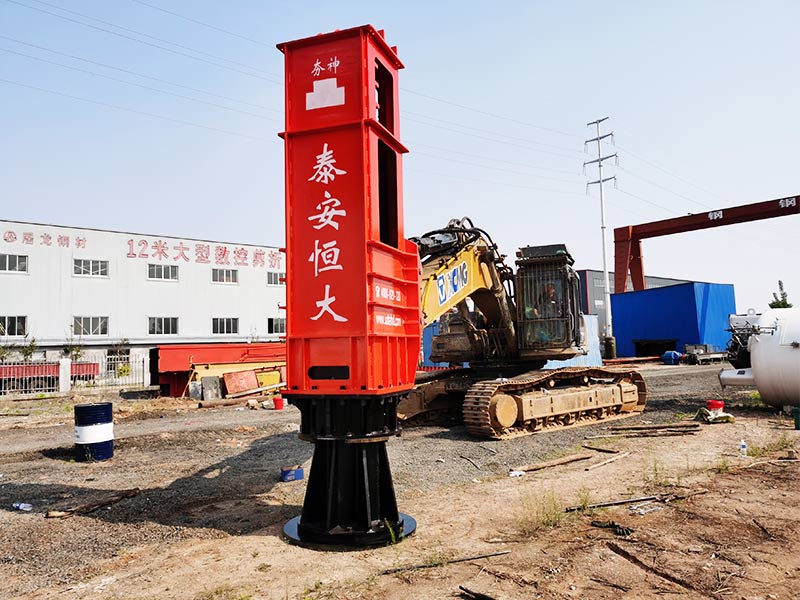What does it mean to have 95% compaction? - HENGDA RIC
- Update time:2023-01-29 11:22:27
- Views:316
This compaction energy brings the soil particles into a more densely packed structure. The compaction energy is transmitted safely and efficiently as the compaction foot remains in contact with the ground. No flying debris occurs during the compaction process. The hammering of the foot by the impact weight is the reason of the sub-soil compaction. Indeed, the huge amount of energy developed upon the hammering process and transmitted to the ground through the foot, pushes the backfilling material into a denser structure.

Treatment depth and design
Typically, the RIC method is used for the treatment of essentially granular fills in order to improve their geotechnical properties (stiffness and bearing capacity) and to reduce settlement. RIC design firstly involves geotechnical characterisation of the soils to be treated, with emphasis placed on quantifying in-situ relative density and grading characteristics. Groundwater level is an important factor for consideration of suitability of the RIC method as shallow groundwater level can act as a hydraulic barrier reducing effective energy transfer to the fill materials. However, it is the “compaction trial” (discussed under testing and quality control), which provides the designer with the necessary information to permit refinement of the design. With ground improvement techniques involving surface impact such as RIC there cannot be direct control of treatment depth, as would be the case with vibro stone columns. A critical element of RIC design therefore is the depth to which a particular treatment is effective.

The selection of the compaction method (DC or RIC) and plant type for a particular project, will depend on ground and groundwater conditions, and requirements for design and execution. Each system has merits and limitations. It is important that these are understood and considered in the design and application of DC/RIC on a particular site and in the context of the prevailing ground conditions. Indeed, it may be necessary for more than one technique to be employed at a particular site to gain maximum benefit.

Numerous developments of the last decades provide a broad range of near-surface compaction technologies (such as static and dynamic rollers) and deep compaction techniques (such as deep vibro-compaction, vibro-flotation and deep vibroreplacement, heavy tamping). However, until recently no device was available for middle-deep compaction. The lately introduced Rapid Impact Compactor (RIC) aims at closing the gap between the surface compaction methods and the deep compaction methods, and permitting a middle-deep improvement of the ground up to a depth of 4 to 10 m.

Small Buildings and Floor Slabs – RIC has been used to improve soil under 2 to 3-story building footings and floor slabs.
Replace Surcharging – Instead of using a surcharge to consolidate the soil under a static weight, Rapid Impact Compaction consolidates it immediately.
Replace Over Excavation – Loose fills or soils can be consolidated immediately without the need to replace the soil.
Improve Lateral Load Capacity for Piles – The lateral load capacity of a pile is greatly influenced by the stiffness of the upper 10 feet of soil in which it is driven. By densifying the upper layers of soil the lateral capacity is greatly increased.
- 2023-02-14How much water required for soil compaction? - HENGDA RIC
- 2023-05-19Rapid Impact Compaction Machine for Highway Construction
- 2023-02-09Rapid impact compaction ltd - HENGDA RIC
- 2022-12-26What are the three types of compaction? HENGDA RIC
- 2023-01-19What does it mean to have 95% compaction? HENGDA RIC
- 2022-09-06What is deep dynamic compaction? RIC manufacturers share
- 2022-08-13Rapid impact compaction (RIC) - China manufacturer
- 2022-08-15Construction specification for rapid impact compaction treatment of foundations
- 2023-02-14How deep is rapid impact compaction? - HENGDA RIC
- 2023-02-09RIC compaction machine for sale - HENGDA Rapid impact compaction
- 2022-08-15What is Rapid Hydraulic Compactor? - Rapid Hydraulic Compactor China Supplier
- 2022-09-28Rapid impact compaction under construction at Dubai Airport in UAE
- 2022-08-15Rapid impact compactor under construction at Xiamen Airport in China
- 2022-08-15Rapid impact compactor at the construction site of Jazan Airport in Saudi Arabia
- 2022-08-15Rapid impact compaction (ric) method commonly used for
- 2022-08-15What is rapid impact compaction method? - Rapid impact compaction manufacturer
- 2022-08-15HC36 Rapid Impact Compaction Equipment in Jiangxi Highway Construction in China
- 2022-08-15Rapid impact compaction in China's Guangdong high-speed construction
-
Rapid Impact Compaction machine tamping depth - how many hammers for Rapid Impact Compaction machine
Take the widely used rapid impact compaction machine as an e...
-
Rapid Impact Compaction Operation Video Daquan-Rapid Impact Compactor Operation Video Tutorial
Rapid impact compaction has remarkable effect in foundation ...
-
Rapid Impact Compaction equipment manufacturer-Rapid Impact Compaction debugging equipment
Rapid impact compactors have two compaction forms in practic...
- Hengda Machinery Co., Ltd
How much is the price of rapid impact compaction, model parameters, etc.


